
This is a design for a densely packed city in space. Why?

The way to get artificial gravity is to spin a circle. There are two ways to support that circle: radial cables through the center, or a hoop of cable through the circle itself. Both ways keep the cables under tension. Which requires more cable? It turns out, if the weight of the cable is negligible, the two approaches are equal.
Proof. Suppose you have 2*pi*x weights of weight 1/x each, as x becomes large, arranged in a spinning circle of radius 1, supported by weightless cables.
The radial cable approach has pi*x cables of length 2 each with a 1/x weight on each end, giving a tension of 1/x, for a total of 2*pi*x length cable under tension 1/x.
The hoop approach can split the hoop into 2*pi*x isosceles triangles, or 4*pi*x right triangles, each with sides of length 1, 1/2x, and about 1. Each of the two cables attached to a weight has to pull 1/2x weight up, but it's at an angle from vertical with a secant of exactly 2x, so it really needs tension of 2x*(1/2x) = 1. That's 1 cable of length 2*pi with tension 1. That could be viewed as x cables with total length 2*pi*x and tension 1/x each, which is identical to the amount of cable and tension required by the radial cable approach. ∎
This means that hoops and radial cables are equivalent if cable weight is negligible. You can even have a hoop with radial cables hanging from it. Any hoops have to be complete, though.
If cable weight is not negligible, the hoop has all the cable in maximum gravity while the radial approach doesn't, so radial is better.
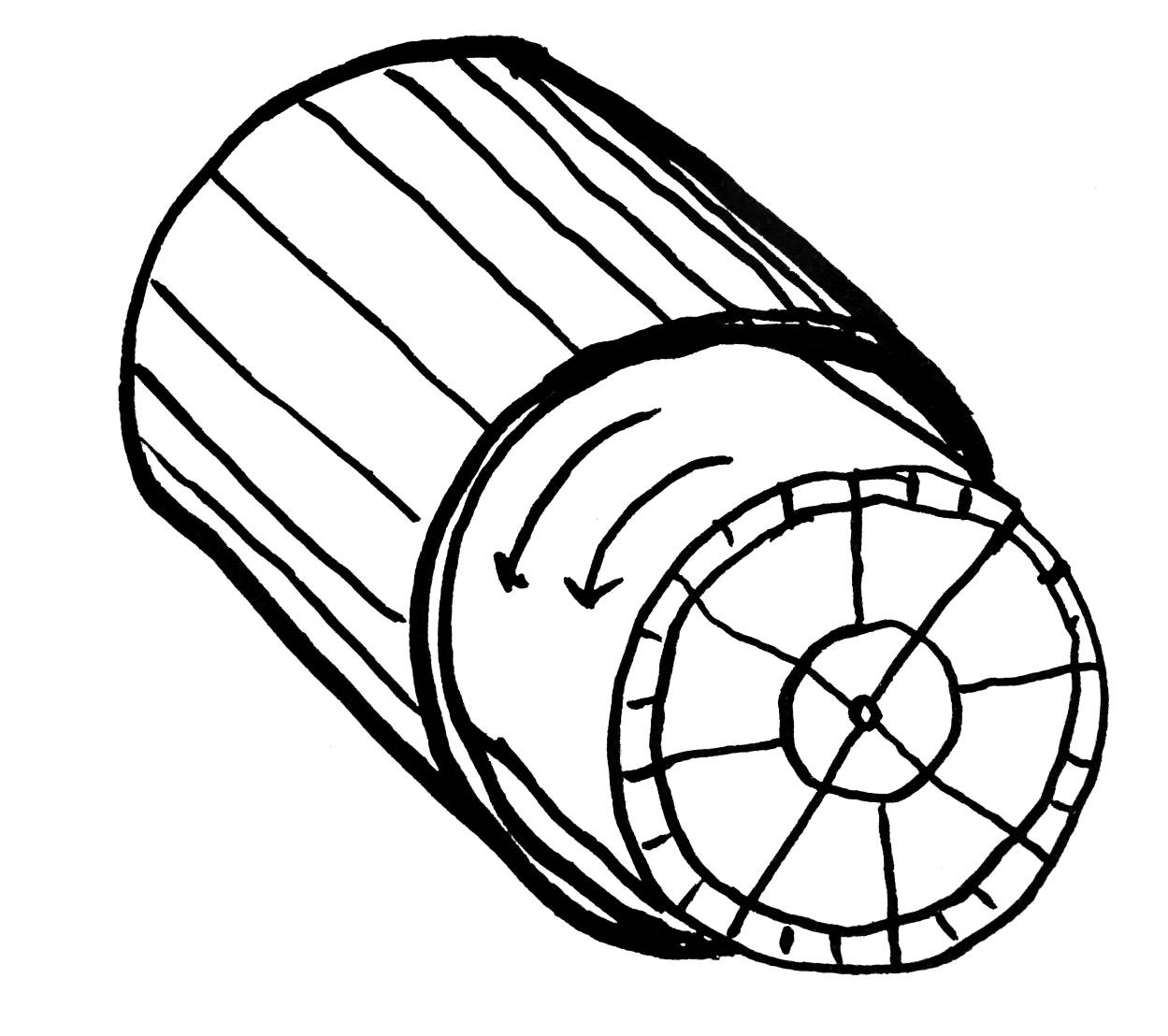
Rotating cylinders are the right idea for human space habitats. Except, you need a fairly massive shielding against meteors, and if you make that a non-rotating cylinder there is no need to support it. The spinning part for artificial gravity would be inside, so it makes sense to be vacuum between the spinning inner part and the outer shield. A densely packed city should be many levels, densely packed, not just the surface of the cylinder. As much as possible should be hung from cables, not built up from a floor, because tension takes less material than compression.
All the levels should rotate at the same rate and be hooked together by cables and elevators. This gives different gravities at different levels, proportional to distance from the central axis. The outer surface of the cylinder should be about 1g.
Since there are many levels all rotating together, and there is a many-meter-thick (5m? 10m?) nonrotating shell surrounding it all, there are no windows. All lighting is artificial. You can have vistas of the inside of the habitat, but you can't see the stars directly from inside.
I do not expect a rotating cylinder with things built up from it towards a hollow center. I expect a dense rotating center with everything hanging out from it, densly packed. Like a rotating Christmas tree in a soup can, or a rotisserie chicken in an oven. Except, you can often use circular hoops for support instead of cables hung from the center.
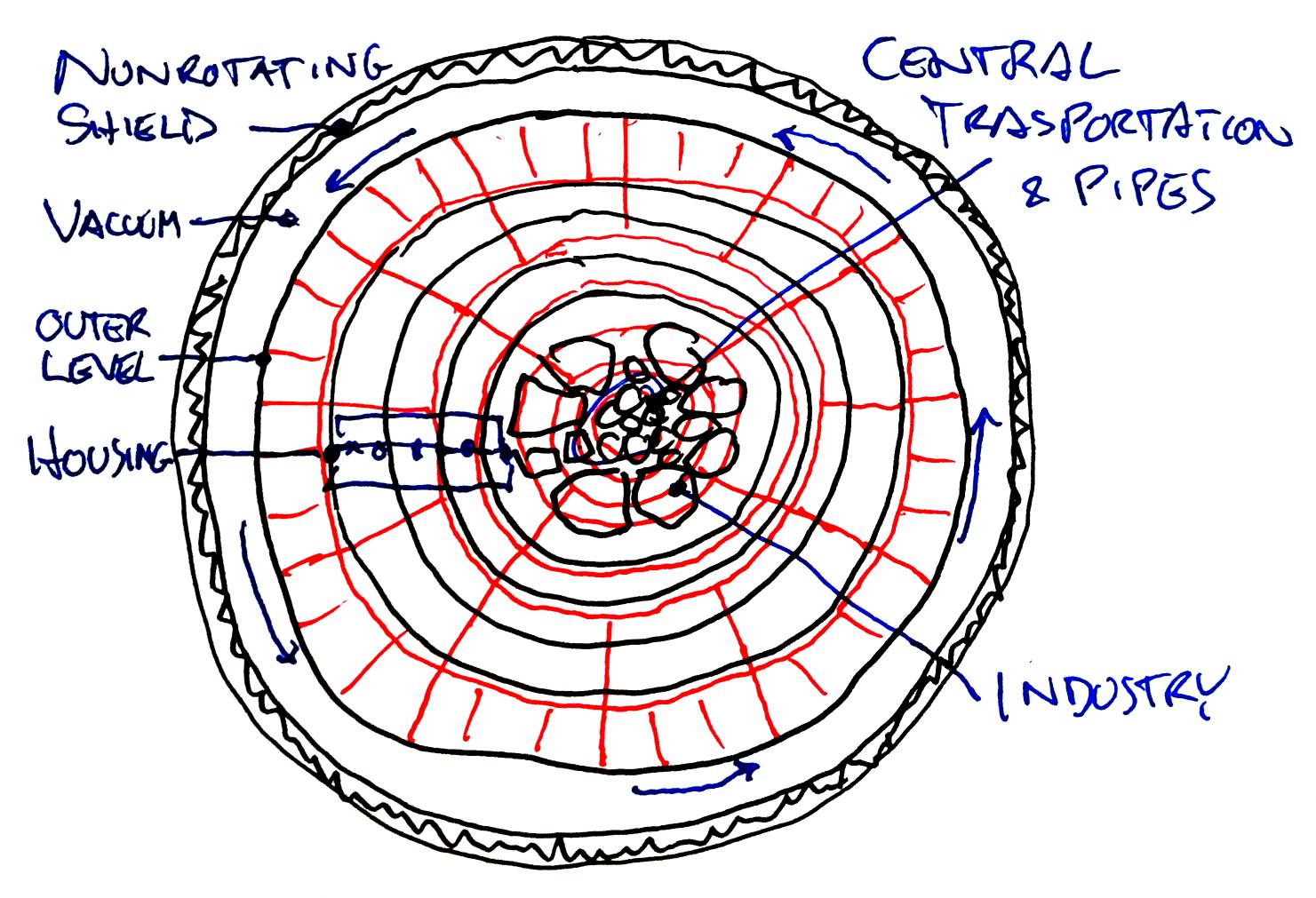
Since gravity varies, different parts of the habitat are good for different things.
The outermost level, at 1g, is good for exercise and recreation. It has to hold in air pressure, which is 15 pounds per square inch. Soil 20 feet deep also weighs 15 pounds per square inch, so you can probably afford 5 feet of soil and some shallow ponds. It could have full sized trees, birds, and animals. Supporting mass there is maximally expensive, so it would be mostly open space with a high ceiling. Radial cables are better than hoops for supporting the outermost level, they would come down like very tall leafless trees.
Massive things are best near the center because it's cheap to support them and move them around there. Transportation likes to be in the center too because it's equally close to all sides, and the trains run out the axis to the connections to other cylinders. Infrastructure (water, steam, food) often has to be shipped in and out the axis endpoints in the center too. Hoops are better than radial cables near the center.
People already use chairs and beds to counteract gravity most of the time, so I expect people to most desire to live in 0.7 gravity most of the time. People value their homes where they eat and sit and sleep, so that should be most of the volume, say 0.4 to 1.0 gravities would be mostly housing and shops and restaurants and roads. It would have a mix of hoops and cables. Hoops are nice because people are used to floors and ceilings being solid. Radial cables can get in the way.
The safe load on a cable is 1/5 of its minimum breaking load. If a habitat is more than 10% support cable by weight, it's probably better to build two smaller habitats rather than one big one. A hoop is 2*pi the length of its radius. So a habitat radius should be no more than 1/(5*10*2*pi)=1/314 the breaking length of the hoop material used. Wikipedia has a table of breaking lengths:
You can suspend the outer cylinder by radial cables rather than hoops, which keeps most of the cable in low gravity and lets you taper the ends that are in high gravity. Hoops for inner levels are both shorter and under lower gravity, so cable required varies with the square of the radius, so hoops are more attractive for inner levels. You could also spend more than 10% of your mass on cables, especially on the outermost level.
The material for these habitats will come from the moon. The moon has oxygen, silicon, aluminum, calcium, iron, magnesium, titanium, but not much carbon or water. The moon's essentially a big pile of broken glass, so glass cables are easy.
Upshot, a 1km radius habitat looks reasonable. It can be done entirely with carbon fiber hoops under 10% of total mass, or glass fiber under 25% of total mass, or probably glass fiber under 10% of total mass with tapered radial cables for the outer levels and most of the non-cable mass in the middle. 1km radius habitats don't look reasonable with steel cables. I know O'Neill cylinders are supposed to be 4km in radius and use maraging steel, but I get a breaking radius of 4.7km for that stuff, so a 4km radius leaves no safety margin and hardly any capacity for extra load.
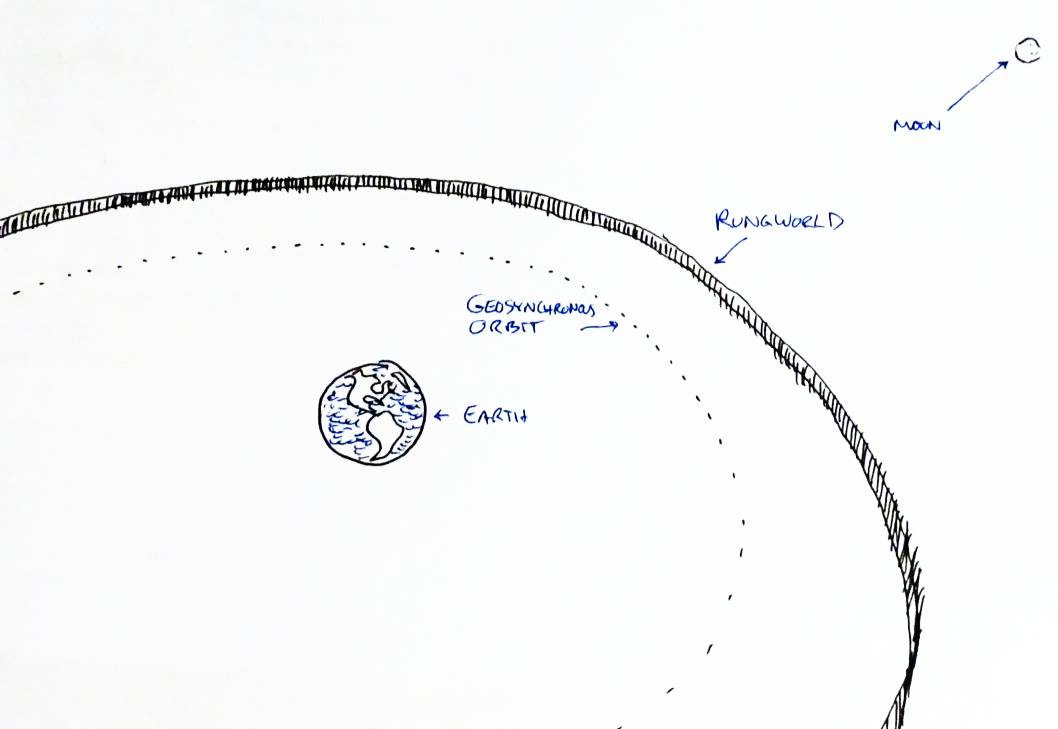
A ringworld is a ribbon that stretches around the sun (or earth) and rotates fast enough to produce artificial gravity. No substance is anywhere near strong enough to do that.
A rungworld looks similar, but it's a bunch of these cylinders described above laid out like rungs in a ladder with cables connecting their ends. The cables would contain high speed trains between the cylinders. Individual cylinder habitats are also called rungs.
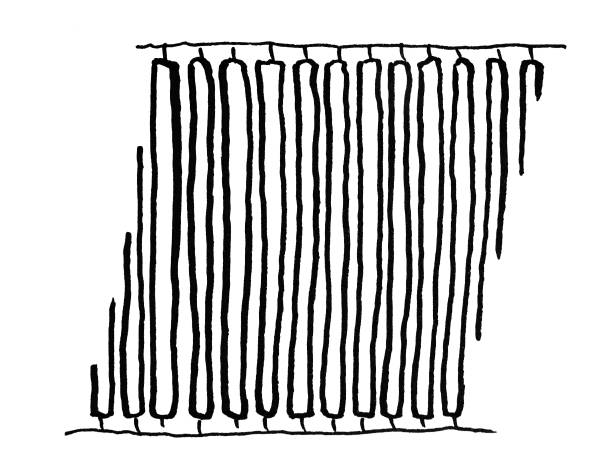
There's no overall force on the cables, so the ladder doesn't have to stretch all the way around the sun (or earth), it could start with one rung and others could be added later. Neighbors ought to rotate in opposite directions so their surfaces are travelling the same speed and the same direction when they get close to each other, reducing the damage of debris from one hitting the next. If the outer shell enclosed multiple neighboring rungs, it is even possible to purposely jump from one rung to another when they are close, although you'd run into the shell at high speed if you miss.
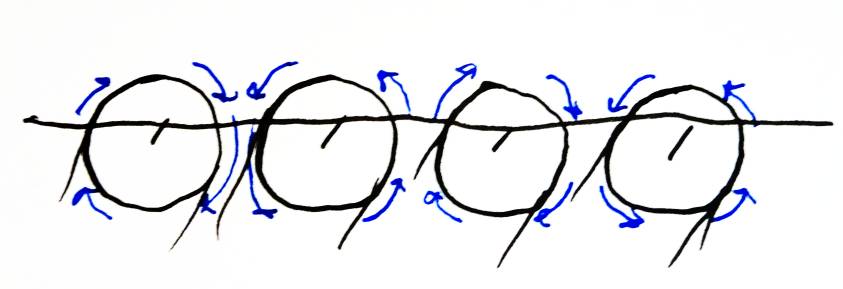
Rungworlds will have no reason to precess if they lie in the ecliptic (the same plane the earth circles the sun in) and the rung axes are perpendicular to the sun. Actually, I'm not sure what a frozen orbit is for a rungworld orbiting earth. It gets pulled by the sun, the moon, and the earth's equator. The sun and moon pull it toward the ecliptic (the moon in a wobbly) while the earth's equator pulls it toward the plane of the equator. Rungs will experience slight tides, but not very much. The 2km variation in distance from the sun, earth, and moon as the rung spins once a minute won't cause much difference in gravity.
People are used to a day/night cycle, and they use less power at night. The rungs would depend on local solar energy hitting the rung (until we learn to use fusion generators). The two edges of the rungworld face the sun edge-on, so twice per orbit each rung will get less solar energy because the sun is blocked by neighboring rungs. If the rungworld orbits earth every 2 days, the reduced solar energy from the rungworld eclipsing itself can correspond to nighttime. That's a distance of 67000km from the earth's center. Geosynchronous orbit is 42000km from the earth's center, and period is radius3/2.
A single cylinder will eventually wobble off its axis and occasionally spin lengthwise instead if their length is much more than their radius. Multiple cylinders hooked together as rungs in a rungworld won't do that, which allows the lengths of rungs to be arbitrarily long. Population grows with the square of the radius, but growing the radius is hard. Population grows linearly with the length, and growing the length is easy. I'll arbitrarily say rungs are 50km in length, but I don't see why they couldn't be 1km or 100km in length.
If a house is 1000 cubic meters (which is bigger than the normal house on earth), and 1/10 of the living quarters is housing, and the outermost level is 1g and living quarters are .4g to 1g, that's 13 million houses and a population of about 13*2.5=33 million people.
If rungs are arranged in a bracelet encircling the earth such that they orbit earth once every two days, that will fit 140,000 rungs. That would be a population of 4.6 trillion if they are all densely populated this way. This doesn't take new materials to build, the raw materials are all in the moon, it's stable, and this could house 300x the entire population of the earth. If the rungs were solid they would consume 14% of the moon's matter, but they're more likely 1% solid, so, 0.14% of the moon.
1000 cubic meter houses and 1/10 of space filled by houses is a rich man's idea of dense living. 100 cubic meter houses filling 1/2 of the living quarters is 50x denser, and would be 1.65 billion people per rung. Manhattan has 35 square meters per person, but that's not counting that buildings have multiple stories.
It would be possible to arrange rungs in a square grid rather than a simple chain and still have neighbors rotate opposite of neighbors. It would pack N times more rungs into the rungworld and square the number of rungs that could be reached (thus population density) in a constant amount of travel time. However only the outer rungs would get sunlight, so either they need to use N times less power, or they need fusion or something to generate power independent of the sun. Even if they use fusion they've got the problem of dumping waste heat to empty space.
Rotation time to produce 1g of artificial gravity is 2*pi*sqrt(radius/(9.8m/ss)). A radius of 1km will have 1 rotation every 63 seconds. A 1km radius is easily big enough to make the floor of a house look nearly flat and prevent dizziness and nausea. The smallest comfortable rotating cylinder with 1g gravity is about .2km in radius.
The living space grows with the square of the radius. Some network effects grow with the population, so bigger population is better. Bigger radius spends less per person on the protective shell, but more on cabling.
Network effects. For example, people choose the best job they can within an acceptable commute. Denser means more jobs to choose from. You could say people should just move close to work, but a married couple where both work can at best move halfway between their two jobs. Another example, you only get a dedicated umbrella shop when the population is above a certain density. Another example is Silicon Valley startups, which are possible because so many software engineers live in close proximity.
The nonrotating protective shell grows only linearly with the radius, so shell cost per person drops with the inverse radius.
The outer rim of the rung always rotates at about 1g. The cable required for the outer rim has to support itself (some percentage of its total mass which grows linearly with the radius), plus load (the amount of cable required to support a given load grows linearly with the radius). The total amount of load is also going to grow linearly with the radius. So radius is worse for cable required: rr/(m-r), where m is the maximum radius allowed by the cabling. When r is much smaller than m it is close to square scaling (same as population), but as r approaches m, increasing the radius becomes prohibitive.
Within a habitat, the cable needed to support someone's stuff scales with the square of the distance from the center to their stuff, reaching a max when their stuff is on outermost level. (Gravity increases linearly with distance, and length of cable also increases linearly with distance, for square of distance total.) If the cable is under 10% of the habitat's total mass, that does limit how bad the cable cost can get, but it can exceed 10% because 10% just limits the average over the whole habitat. The habitat's heaviest stuff is typically in the center at near zero gravity.
The population grows linearly with the length, and length linearly increases both the protective shell and the cable, so network effects get better with no extra cost per person as length increases. So longer length is better. Normally a rotating cylinder is unstable if its length is more than its diameter, but the rungworld connections at the ends of the axis automatically dampen any such instability, so that isn't a limit on length. The limits on the length are some other factors, perhaps transportation time along the rung vs taking trains to other rungs, or amount of traffic in and out of the rung through the axis endpoints.
Air pressure is highest at the outermost level. Since gravity drops to zero at the center, it's an air pressure drop as if the center was 1/4km higher than the outermost level instead of 1km. That's a tolerable variation in air pressure. Nothing special needs to be done about air pressure variation in a 1km radius habitat. If graphene allowed 20km radius cylinders, there would have to be an airtight level every half kilometer or so, and elevators between levels would have to be airtight and adjust air pressure as they go up and down.
Directions are up, down, north, south, east, west. Since the axes of the rungs are aligned with the axis of the sun, which are within 23 degrees of the axis of the earth, north is earth's north and south is earth's south. Standing inside the rung, east is right from north and west is left from north. This matches east and west from the perspective of someone standing on earth. The rung's east matches earth's east when standing in the rung and the point is nearest earth, but matches earth's west half a minute later when that point is at its furthest from earth. Whether east or west corresponds to the direction of rotation will vary with the direction the rung is rotating. Neighboring rungs will rotate in opposite directions for safety reasons and stability.
Distance in a city is measured in time rather than distance. Europe and Japan already have a series of trains moving at different speeds, with faster trains having stops further apart. Moving at constant distance from the central axis is much easier than than moving in and out from the center. The natural ratio of length to radius would be the one that makes it take equally long to travel around the shell vs from the shell to the center vs traversing the whole length of the rung. Around the shell is 2*pi*radius, so I'm guessing 2*pi*radius is a minimum for the length, but shell to center probably takes much longer than horizontal making a longer length more reasonable. Express trains can go faster with larger distances, so the length should be much larger than the diameter. Transportation around the circumference would gain weight in the direction of rotation, and lose weight going counter to rotation. With a 1km radius, 360km/hour counter to rotation would be zero gravity. Transportation time would be dominated by switching trains rather than actual travel.
Transit between rungs is a straight shot in zero gravity. There would again be a series of trains for short or long hops. They could increase in speed exponentially, with one level speeding up to match the next level, exchanging passengers, then slowing down to meet the previous level, exchange passengers, repeat. There is likely enough traffic to require many trains at all speed levels. Even so the tube connecting rungs is likely to be much smaller than the 1km radius of the rungs themselves.
Growing food, recycling waste, maybe generating power would have to be handled elsewhere. Converting carbon dioxide to oxygen + carbon has to be done on site, that requires more power and produces more heat. Removing heat is done by ice and water cooling. It is easy to producing steam on the sun-facing side, so supplying the habitat with steam as well as icewater seems practical. The food etc would have to be imported from further away. I haven't fleshed out the food. So far humans have managed to grow a few small tomatoes in space. Here I was just looking at how to make a dense 3D human city.
Melting ice is 144 BTU per pound, and people are comfortable at about 70 degrees F, so ice-to-water is 214 BTU per pound. A human generates 330 BTU per hour, double that for extremely efficient appliances, so 660 BTU per hour, or 1.4 liters of ice-to-water per hour. For the city of 33 million people, that's 45 million liters of water per hour that needs to be carried away and an equal amount piped in. If it were flowing 10km/hour, I get 4.7m radius pipes in and out at each end of the city. That seems plausible.
Cooling is just pointing the water at empty space (the sun can be blocked). The first internet spot I saw said blackbody radiation to outer space is about 448 watts per square meter per second, and 1055 watt-seconds is a BTU, so ... 14 million square meters? The rung's non-sun side is 100 million square meters, so the rung could radiate it itself. If rungs are packed in a grid that wouldn't work. Blackbody radiation grows with the fourth power of temperature, so a workaround is to use a heat engine to greatly raise the temperature (requires extra energy), then radiate at that higher temperature, then convert back to low temperature (requires extra energy again).
Radiation would be done from the outer shell, which is also guarding against meteors. Both cooling and blocking meteors need a lot of mass. So part of the shielding would be the water being cooled. So you want the radiating stuff not rotating, even though it is rotating when it is in the city. The way to do that is pipe warm water up to the center while rotating (and pipe and equal amount of ice water back down, transferring angular momentum between the two) then pipe the warm water down to the shell non-rotating. A non-rotating pipe has to go through a region that does not contain a rotating city, so it would be beyond the ends of the city, connected by the center.
The city would naturally be divided in north and south sections, depending on whether the pipes flow to the north or south end of the rung. The city would grow in slices added at either end, with the oldest slice of the city in the center. Manhattan city blocks are 80 x 274 meters. If a slice is 274 meters across, a 50km length city has 182 slices. The initial slice does not have to be solid, or even extend to the full 1km radius. It could be just a single hoop, with later hoops eventually filling in the whole disk. This allows the city to be built up gradually, starting from a very small seed. It can be arbitrarily small if you start with a higher rotation rate and living in smaller rings, but that requires everyone moving to new housing if the rotation gets slowed down too much for the final speed.
Sunlight is 1360 watts per square meter, and each rung has 100 square kilometers facing the sun. We're currently good at making 20% efficient solar cells, though 30% has been manufactured and 39.5% has been achieved in a lab for a non-concentrating cell. 30% efficient solar cells would be 41 billion watts, or 1200 watts per person. I see US residential consumers average 1240 watts, but I think that's a residence not a resident, so really 500 watts per person. Electricity from sunlight falling on the rung is probably enough.
There would be no gas or flame, all appliances would either use electricity or icewater/steam that is piped everywhere. Ambient habitat temperature would be about 70 F (21 C) during daytime and 65 F (18 C) at night. House temperature would be controlled by icewater or steam. Without either, a used house will rise to about 75 F (24 C) and stay there. Showers and washing dishes use hot water kept hot by steam. Refrigerators use icewater. Freezers need electricity, but they can use icewater as the temperature to radiate into instead of room temperature. Ambient lighting would be like a shopping mall: good for reading during the day, deep twilight at night. (I don't know if steam pipes are worthwhile, or heating water by electricity is better. Heating water with solar-cell-produced electricity is wasteful, but so is maintaining steam pipes everywhere.)
People like 65 F (18 C) weather plus direct sunlight. That requires both cooling the air and generating a lot of infrared light, so it's not very economic. It can be done for special occasions, but that's not what the typical daytime environment will be.
Televisions and computer displays use power. Lighting is all artificial and uses power. Home surveillance cameras and computers use power. Stoves and ovens use power. Cars are small electric cars, maybe nearly golf carts, because trains handle all the long-haul traffic. Clocks, smoke alarms, loudspeakers use power. Vacuum cleaners and electric drills use power.
The entire city rests on strong cables under tension. If you hit such a cable, vibrations travel along its length. The whole city will constantly have a low level of vibration going on. It will never be totally quiet. Small things can use this to power their batteries, especially if they rest against a cable directly.
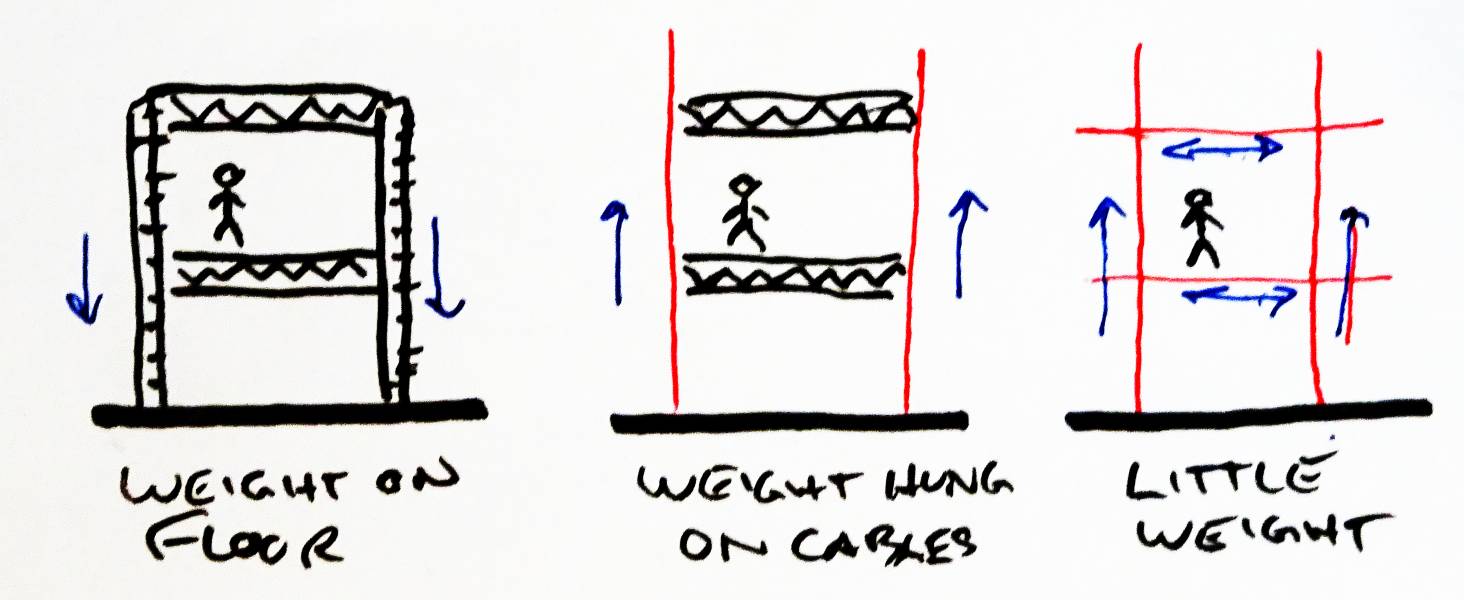
Buildings should be suspended down from the ceiling, not built up from the floor. Skyscrapers are easy, but they would not be stone or concrete, they would hang off a cable. Actually skyscrapers would look different: instead of being big on the bottom and going up to a point, they would be big on the top and come down to a point, like stalagtites. They could be big fat pyramidal stalagtites or sheer equal-width buildings top to bottom, kilometer tall is no trouble. Office windows could be slanted out so you could lean against them and look hundreds of meters down.
One way to use hoops as primary support is to have a hoop every 3 meters forming the floors/ceilings of houses. This would cause a continuous row house all the way around the habitat. They could be any number of floors, since each floor is self-supporting. There would have to be a missing floor where north-south avenues have to run through.
Houses have 3 meters per floor, which suggests a level every 9 meters, since people aren't willing to walk up more than about 3 flights of stairs. There will be restaurants, hospitals, fire stations, police stations, government buildings, businesses, churches. Churches traditionally want to be very tall. But that's reaching towards heaven. I don't know if that motive will carry over in these habitats since they'd actually be reaching towards the center. There will be schools. Children are willing to walk up more than three flights of stairs, which means schools can gather students from multiple levels, which means schools will be within walking distance.
There would be lifts that can carry cars from one level to another, but that will be rare. Usually the roads will be foot traffic, bicycles, mopeds, golf carts. Fire engines will use the roads but stay on one level. With foot traffic on roads, it is good to mix storefronts and restaurants with residential housing. Retail is usually on the ground floor, which encourages having few stories between levels, so there are more ground floors.
Walking along a hoop is at most 6.28km, it can be done in an afternoon. Walking from one end of the city to the other is 50km, which can be done in about two days. But there are 5000km of roads on the outermost level, and if there was a level every 10 meters on average that's a quarter million kilometers of roads total in a rung. That's a lot of neighborhoods to explore.
It's natural to have circumference streets be hoops. (In Seattle, north-south roads are avenues and east-west are streets, so all circumference roads would be "streets".) It's possible to have the circumference streets be the main, or even only, support for the habitat, with everything else hung from them.
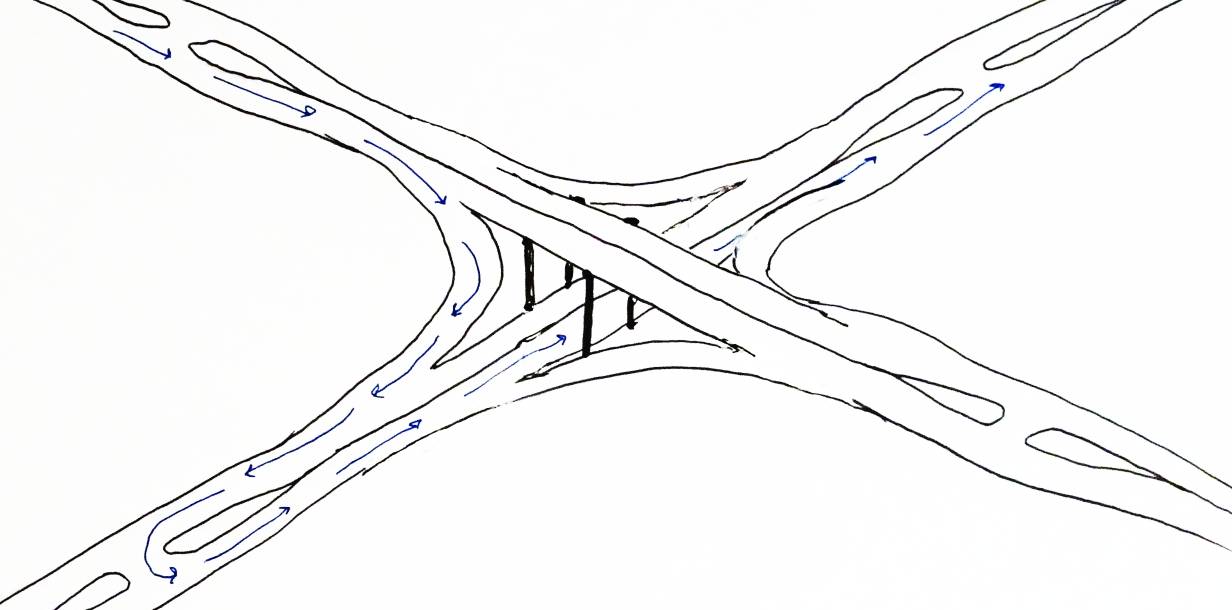
If circumference streets are four meters above lengthwise avenues at the same level, with on and off ramps connecting, then there are no intersections or traffic lights. Assuming traffic on the right, left turn on-ramps require cloverleafs, which take up a lot of space. But right turns at intersections plus U-turns between intersections is close to as good as allowing left turns. Most roads will carry only very maneuverable traffic like pedestrians and carts and bicycles, with dedicated public transportation for the long distances and heavy loads. So I expect level U-turns plus intersections with only right turns that go up or down 4 meters. Most plazas near intersections will have two levels of shops, with open spaces and stairs and little elevators connecting them.
I don't know whether that would happen, or if intersections would be preferred. Pedestrians don't want to walk to the U-turn. I don't know if bicycles even would. Bicycles would prefer that the ground stays level (well, constant distant from the central axis). It takes cars to care about traffic lights. Cars would be discouraged.
Guns are not allowed inside a habitat. There's no wildlife to shoot, just people. If The Goverment decides to persecute you, guns won't help you, they can turn off your air and water and electricity. There would be a police force, roughly equivalent to New York City Police. Police can have guns, they have a monopoly on the right to use guns.
Politics in dense-packed rungs will be similar to existing big cities on earth. Neighbors have to coexist, and there are lot of neighbors.
Politics across the rungworld, though, is much more anarchic. There's no reason for one rung to talk to another if it doesn't want to. You can even detatch a rung and move it to somewhere else, though its spin isn't as stable if it's disconnected. I think a pair of rungs rotating in opposite directions is stable.
It's pretty easy to destroy a rung if you want to. The answer to that is mutually assured destruction. So rungs can do whatever they want, so long as it isn't harming earth or other rungs. Destroying another rung (or dropping rocks on earth) will get your rung destroyed by some international coalition.
You can't get satellite reception directly from the center of a rung, there's too much matter in the way, it has to be some form of wifi.
The rung itself has satellite reception unimpeded by atmosphere. The rungworld is big, .2 light seconds from earth, .4 light seconds from the other side of the rungworld, and about 1 light second from the moon. (The moon will most definitely be populated as well, even before the rungworld is built, because that's where the matter for the rungworld came from.) About 6% of the rungworld will be permanently eclipsed by the earth, so talking to that will require relays. People notice delays .2 to 1 second, so cached content is the default except for realtime communication.
Soil is dirty and wet, which is not good for machinery. There will be places where only potted plants are allowed, and places with dirt and grass and small trees. Big trees are heavy compression structures so they won't be common.
Perhaps some rungs will be all open space with mature forest and wildlife and extra hefty cables to support the monster trees, but these densely packed rungs won't have very big trees.
If you want more greenery, and also a dense population, well, people don't walk on the walls and ceilings. Have climbing vines on the walls and ceilings, maybe flowering or with fruits, and provide trellises for even more of them. You could aim at the experience of walking under a banyan tree rather than walking under an open sky. Light sources can be anywhere. Light sources can be small and bright, or diffuse and whole walls. Massive amounts of greenery are cheaper closer to the center.
In dense-packed rungs, it's unlikely there will be enough greenery to produce enough oxygen and remove enough carbon dioxide for the habitat to function. On the space station, electrolysis produces oxygen and the Sabatier System captures the carbon dioxide but produces methane. The rung needs to further reduce the methane to higher weight molecules that can be fed to plants. Providing oxygen and removing carbon dioxide should be done within the rung, but converting methane might be done outside the rung, and growing food would definitely be done (mostly) somewhere else.
Sewage needs to be pumped up to the central axis then shipped out to be treated elsewhere, with the organics feeding crops. I haven't run the numbers on the volume of sewage, but I'm guessing it's in the same ballpark as the ice water recycling. I expect the ice water coming in all gets sent out as sewage.
Trash also has to be 100% recycled. In space you should not throw away matter at all. We don't know how to do this so far. This level of recycling, and growing food in space, are big holes in this design.
There will be wildlife purposely placed in the outer level, and some of that will find ways to make homes in the inner levels too. There will be bugs and birds flying around.
Residents would have to pay tax on their share of cable maintenance, and maybe on their share of cable ownership itself. Amount of cable required for a given mass increases with the square of the distance from the center, and it would scale with the mass of what they own. There may be extra charges or discounts if weight is asymmetric about the center.
They'll have to pay taxes on space used. Space cost varies by location, but I imagine economic factors will determine what space costs where and it will vary over time.
There will be something like income taxes, too, even though there's nothing space-habitat-specific about income taxes.
There will be utility bills for icewater, steam, electricity, sewage.
I expect air will be free. Even a 20km graphene rung, with different airlocked zones, would be better off lumping air expenses with property taxes somehow. Taxes ought to be progressive, slightly superlinear with wealth. Air is consumed equally by everyone no matter what their wealth, so charging that is a very bad tax. There is other common infrastructure that will also probably be rolled into property or income taxes.
I hope for a Universal Basic Income, accompanied by a minimum wage of $0 since people can survive off UBI without working, but that's not a rungworld-related hope. A survivable UBI eventually has to be accompanied with population control, perhaps you don't get UBI if you have 4+ children and some of those children are under age 20.
The food for the city comes from separate farming habitats. The city has no way to force them process their waste into food. The city has to pay a competitive price, otherwise the farms will switch their business to doing something else. The city is remarkably cost-efficient per human being, but still, the humans on average have to earn their bread. Otherwise they won't get it and the city will shrivel.
Agricultural rungs do not need high gravity. It probably helps to have a little gravity, but 0.1g or 0.01g may be enough.
Agricultural rungs have light as their limiting factor. Using concentrators, and light pipes through the meteor shield that are bent so meteors can't go through the pipe, and luminaires to spread the light once it is inside, 65% of the sunlight can get inside. Solar cells converting to electricity then back to light can do 20% at best. So natural lighting with concentrators and light pipes wins.
The nonrotating outer shield isn't quite nonrotating. Two natural speeds for it to rotate are once every two days (stationary with respect to the rungworld and earth) and once a year (stationary with respect to the sun). If the shell is fixed relative to earth, the concentrators need to rotate to match the sun, but if the shell is fixed relative to the sun, no moving parts are required for the concentrators and light pipes. So the shell tracking the sun wins. That means both the inside and the shell rotate with respect to the rungworld, and there need to be bearings for each.
The most efficient food to grow at the moment is algae, which converts 8% of the sun's energy to biomass calories. The sun produces 1361 watts per square meter. Multiply by 2/pi to account for the rungworld eclipsing itself once a day. Humans need about 3000 kilocalories per day. A watt is 20.6 kilocalories per day. A 50km rung with 1km radius has 2*50=100 square km facing the sun. Combine all those, and a 1km radius rung can feed 100 * 1e6 * 1361 * (2/pi) * 20.6 * .65 * .08 / 3000 = 31 million people. Compared to 33 million people per population rung. There's extra overhead, so there will be about twice as many kilometers of rungworld dedidated to agriculture as dedicated to population. Instead of 2 ag rungs per 1 pop rung, it may be 20 ag per 1 pop, with each ag 1/10th the radius, since there is no point in ag rungs having volume that they can't keep adequately lit.
Unlike agricultural rungs, population rungs probably prefer their shells to be fixed relative to the rungworld rather than fixed relative to the sun, with a shell surrounding a pair of counterrotating rungs. This would allow jumping from one rung to another at the points they are almost tangent, effectively doubling the population that can be reached without going through the cables connecting rungs.
Populations will prefer to visit other populations, not agricultural rungs. So population rungs will be clumped and agricultural rungs will be clumped. Sewage and food have to be shipped between population and agricultural rungs in bulk, so they can't be too far apart. The irregular banding of population clumps and agricultural clumps will be visible from earth, and can be used to pick out known locations in the rungworld.